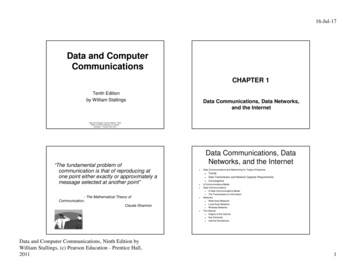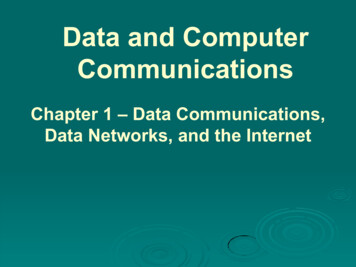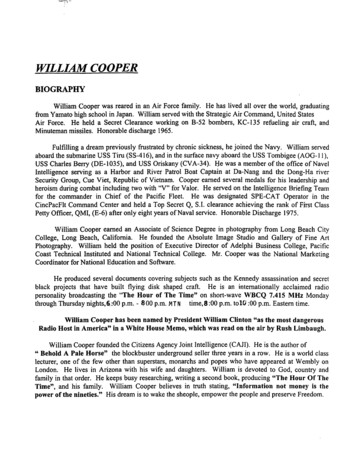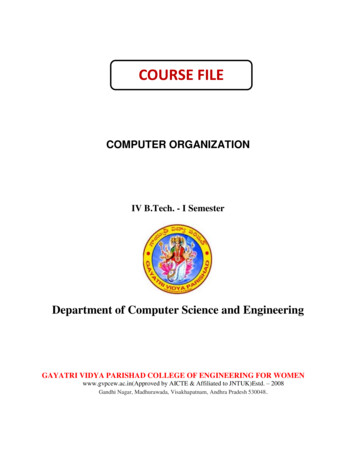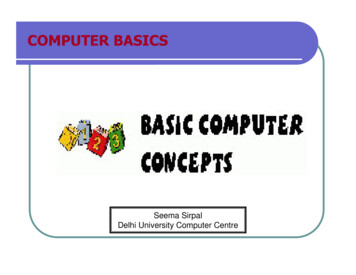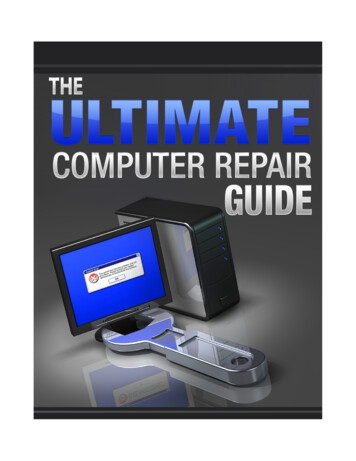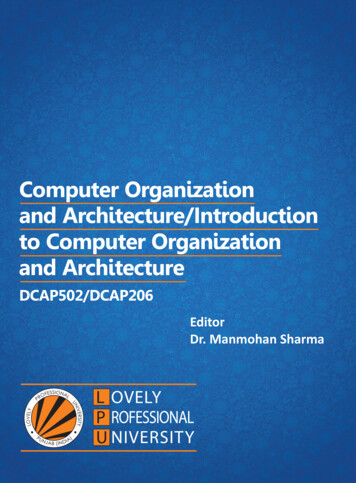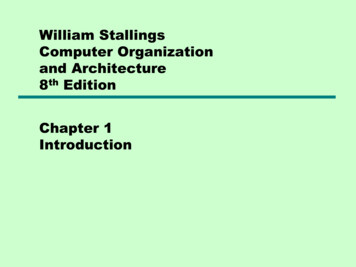
Transcription
William StallingsComputer Organizationand Architecture8th EditionChapter 1Introduction
Architecture & Organization 1 Architecture is those attributes visible tothe programmer—Instruction set, number of bits used for datarepresentation, I/O mechanisms, addressingtechniques.—e.g. Is there a multiply instruction? Organization is how features areimplemented—Control signals, interfaces, memorytechnology.—e.g. Is there a hardware multiply unit or is itdone by repeated addition?
Architecture & Organization 2 All Intel x86 family share the same basicarchitecture The IBM System/370 family share thesame basic architecture This gives code compatibility . at leastbackwards Organization differs within members ofthe same family, e.g. floating point numerical co-processors with names like 8087, 80287 and 80387. Withvery few exceptions, the 80486 and subsequent x86processors then integrated this x87 functionality on chip.
Structure & Function Structure is the way in which componentsrelate to each other Function is the operation of individualcomponents as part of the structure
FunctionGeneral computerfunctions:—Data processing—Data storage—Data movement—Control
Operations (a) Data movementI/O (peripherals directly attached)Communications/Networking(communication lines)Example application?
Operations (a) Data movementI/O (peripherals directly attached)Communications/Networking(communication lines)Camera attached to a PC,sending the frames to awindow on the screen of thesame PC.
Operations (b) StorageExample application?
Operations (b) StoragePlaying an mp3 filestored in memoryto earphones attachedto the same PC.
Operation (c) Processing from/to storageExample application?
Operation (c) Processing from/to storageAny number-crunchingapplication that takesdata from memory andstores the result back inmemory.
Operation (d)Processing from storage to I/OExample application?
Operation (d)Processing from storage to I/OReceiving packets over anetwork interface, verifyingtheir CRC, then storing themin memory.
Structure - Top inesMainMemory
Structure - The CPUCPUComputerArithmeticandLogin UnitRegistersI/OSystemBusMemoryCPUInternal CPUInterconnectionControlUnit
Structure - The Control UnitControl olUnitControl UnitRegisters andDecodersControlMemory
William StallingsComputer Organizationand Architecture8th EditionChapter 2Computer Evolution andPerformance
ENIAC - background Electronic Numerical Integrator AndComputer Eckert and Mauchly University of Pennsylvania Trajectory tables for weapons Started 1943 Finished 1946—Too late for war effort Used until 1955
ENIAC - details Decimal (not binary)20 accumulators of 10 digitsProgrammed manually by switches18,000 vacuum tubes30 tons15,000 square feet140 kW power consumption5,000 additions per second
von Neumann/Turing Stored Program conceptMain memory storing programs and dataALU operating on binary dataControl unit interpreting instructions frommemory and executing Input and output equipment operated bycontrol unit Princeton Institute for Advanced Studies(IAS) computer Completed 1952
Structure of von Neumann machine
To do in NOTEBOOK for next timeSection 1.3 Know the definitions of all Key Terms Answer all review questionsSection 2.1 Be able to draw the IAS/von Neumanndiagram – fig. 2.1
IAS - details1000 x 40 bit words, each word representing—One 40-bit binary number—Two 20-bit instructions:– 8 bits opcode– 12 bits addressSet of registers (storage in CPU)— Memory Buffer Register— Memory Address Register— Instruction Register— Instruction Buffer Register— Program Counter— Accumulator— Multiplier Quotient
John von Neumann and the IAS machine, 1952
IAS organizationMemory Buffer Registereither sends data to or receivesdata from Mem. or I/OMemory Address Registerspecifies which Mem. locationwill be read or written nextControl signals are set bythe opcode part of theinstruction bits.Examples: Bring a new instructionfrom Mem. (fetch) Perform an addition(execute)
IAS organizationWhy do we need botha register and a bufferregister to holdinstructions?Why does the arrowbetween PC andMAR point bothways?
IAS organizationHint: 2 instructionsare stored in eachmemory wordHint: the next instructioncan be found eithersequentially, or through abranch (jump)
IAS – the FETCH-EXECUTE cycleEach instruction is executed in the same twostep manner: FETCHload the binary code of the instr.from Memory (or IBR)—Opcode goes into IR—Address goes into MAR EXECUTEsend appropriate controlsignals to do what the instr. needs to do
IAS FETCHEXECUTE cycle
IAS – instruction set (architecture!)Specifies one of 21 instructionsThere was no assembly language back then!
IAS – instruction set (continued)
Programming the IAS Write a program to add two numbersstored in memory at addresses 0 and 1 andstore the result in memory at address 2 To do in notebook for next time:—Write a program that compares the numbersstored in memory at addresses 0 and 1 andplaces the larger one at address 2
IAS extra-credit question (due next class)Why are there 12 bits for the memoryaddress?
Commercial Computers 1947 - Eckert-Mauchly ComputerCorporation UNIVAC I (Universal Automatic Computer) US Bureau of Census 1950 calculations Became part of Sperry-Rand Corporation Late 1950s - UNIVAC II—Faster—More memory
IBM Punched-card processing equipment 1953 - the 701—IBM’s first stored program computer—Scientific calculations 1955 - the 702—Business applications Lead to 700/7000 series
Second generation of computersTransistors Replaced vacuum tubesSmallerCheaperLess heat dissipationSolid State deviceMade from Silicon (Sand)Invented 1947 at Bell Labs by WilliamShockley et al.
Transistor Based Computers NCR & RCA produced small transistormachines IBM 7000 DEC (Digital Equipment Corporation) wasfounded in 957—Produced PDP-1 in the same year
Third generation of computers:Integrated Circuits A computer is made up of gates, memorycells and interconnections All these can be manufactured eitherseparately (discrete components) or on the same piece of semiconductor(a.k.a. silicon wafer)
Generations of Computers Vacuum tube - 1946-1957 Transistor - 1958-1964 Small scale integration - 1965 on—Up to 100 devices on a chip Medium scale integration - to 1971—100-3,000 devices on a chip Large scale integration - 1971-1977—3,000 - 100,000 devices on a chip Very large scale integration - 1978 -1991—100,000 - 100,000,000 devices on a chip Ultra large scale integration – 1991 —Over 100,000,000 devices on a chip
Moore’s Law Increased density of components on chip Gordon Moore – co-founder of Intel Number of transistors on a chip will double everyyear Since 1970’s development has slowed a little— Number of transistors doubles every 18 months Cost of a chip has remained almost unchanged Higher packing density means shorter electricalpaths, giving higher performance Smaller size gives increased flexibility Reduced power and cooling requirements Fewer interconnections increases reliability
Growth in CPU Transistor Count
IBM 360 series 1964 Replaced (& not compatible with) 7000series First planned ―family‖ of computers—Similar or identical—Similar or identical—Increasing speed—Increasing numberterminals)—Increased memory—Increased costinstruction setsO/Sof I/O ports (i.e. moresize Multiplexed switch structure
DEC PDP-8 1964First minicomputer (after miniskirt!)Did not need air conditioned roomSmall enough to sit on a lab bench 16,000— 100k for IBM 360 Embedded applications & OEM BUS STRUCTURE
DEC - PDP-8 Bus Structure
Semiconductor Memory 1970 Fairchild Size of a single core—i.e. 1 bit of magnetic core storage Holds 256 bitsNon-destructive readMuch faster than coreCapacity approximately doubles each year
To do for next time Read from text for next time: Ch. 2 untilMicroprocessors (p.36) Take notes in notebook!
1-minute Quiz What is a word in a computer? (p.20) Do you think the word size pertains tocomputer architecture or to computerorganization? Explain!
1-minute Quiz The computer industry’s first plannedfamily of computers was:—The—The—The—TheSperry-Rand UNIVACIBM System/360DEC PDPIBM System/7000
1-minute Quiz What was each of these computer’s claimto fame?—The—The—The—TheSperry-Rand UNIVAC IIBM System/360DEC PDP-8IBM 701
1-minute Quiz The text states that the latestsemiconductor memories store 16 Giga-bitson a single chip (it’s the binary Giga, 230) Assume that the word size is one Byte How many address lines are needed?
Programming the IASWrite a program that compares the numbersstored in memory at addresses 0 and 1 andplaces the larger one at address 2
Programming the IASWrite a program that compares the numbers storedin memory at addresses 0 and 1 and places thelarger one at address 2 Remember: In a von Neumann architecture, bothdata and program are in the same memory! Let’s start storing the program at address 42(decimal) Data segment and code segment – draw thememory map!
Microprocessors - Intel 1971 - 4004—First microprocessor—All CPU components on a single chip—4 bit—Multiplication by repeated addition, nohardware multiplier! Followed in 1972 by 8008—8 bit—Both designed for specific applications 1974 - 8080—Intel’s first general purpose microprocessor
1970s ProcessorsIntroducedClock speedsBus widthNumber oftransistorsFeature 1972197419781979108 kHz108 kHz2 MHz4 bits8 bits8 bits16 bits8 bits2,3003,5006,00029,00029,00063664 KB1 MB1 MB10640Bytes16 KB5 MHz, 8 MHz,10 MHz5 MHz, 8 MHz
1980s ProcessorsIntroduced80286386TM DX386TM SX486TM DX CPU198219851988198916 MHz - 33 MHz25 MHz - 50 MHz6 MHz Clock speeds12.5MHzBus widthNumber oftransistorsFeature size (µm)AddressablememoryVirtual memoryCache16 MHz - 33MHz16 bits32 bits16 bits32 bits134,000275,000275,0001.2 million1.5110.8 - 116 MB4 GB16 MB4 GB1 GB64 TB64 TB64 TB———8 kBSee more tables in the text, p.39!
2.2 Designing for performance Today’s computer basic building blocksare still the ones of the IAS!. But many ―tricks‖ have been invented toimprove performance
Some of the main “tricks” PipeliningOn board cacheOn board L1 & L2 cacheBranch predictionData flow analysisSpeculative execution
Performance Balance Processor speed increased Memory capacity increased Memory speed lags behind processorspeed—See Fig. 2.10 on next slide
Logic and Memory Performance Gap
Solutions Increase number of bits retrieved at onetime—Make DRAM ―wider‖ rather than ―deeper‖ Change DRAM interface—Cache Reduce frequency of memory access—More complex cache and cache on chip Increase interconnection bandwidth—High speed buses—Hierarchy of buses
I/O Devices Peripherals with intensive I/O demands—E.g. Computer clusters Large data throughput demandsProcessors can handle thisProblem moving d interconnection buses—More elaborate bus structures– E.g. InfiniBand—Multiple-processor configurations
Typical I/O Device Data Rates
Key is Balance among: Processor componentsMain memoryI/O devicesInterconnection structures
To do for next time Read from text sections—2.3 – Evolution of Intel x86—2.4 – Embedded systems and the ARM Take notes in notebook!
Embedded Systems - ARM ARM evolved from RISC design Early 1980s: Acorn Computers (ARM Acorn RISC Machine) Although initially intended for a generaluse microcomputer, today it’s used mainlyin embedded systems—Used within a larger product—Not a general-purpose computer—Dedicated function—E.g. Anti-lock brakes in car
Embedded Systems Requirements Different sizes—Different constraints, optimization, reuse Different requirements—Safety, reliability, real-time, flexibility,legislation—Lifespan—Environmental conditions—Static v dynamic loads—Slow to fast speeds—Computation-intensive vs. I/O-intensive—Discrete-event vs. continuous dynamics
Possible Organization of an Embedded System
ARM Designed by ARM Inc., Cambridge,England It’s not a processor, but an architecture! AMR licenses it to manufacturers As of 2007, about 98 percent of the morethan one billion mobile phones sold eachyear use at least one ARM processor
Improvements in Chip Organization andArchitectureThe main goal/driver is the increase of CPUspeed
How to increase CPU speed1. Increase hardware speed of processorHow? Shrinking logic gate sizePros: Smaller transistorsmaller capacitance— Smaller RC— Smaller current per gate Shorter wiressmaller Rsmaller RC Gates closer togethershorter ―speed-of-light‖propagation delay
How to increase CPU speedShrinking logic gate sizeSource: Wikipedia
How to increase CPU speed1. Increase hardware speed of processorHow? Shrinking logic gate sizeCons: Connection wires are packed closer togetherlarger ―parasitic‖ Clarger RC Thinner wireslarger Rlarger RC Power dissipated by a switching CMOS gate isgiven by ―f C V2‖ formula
How to increase CPU speed1. Increase hardware speed of processorInstead of a conclusion: Intel sets the bar at 4GHz - CNET News, Nov. 2003 Intel kills plans for 4GHz Pentium - CNET News,Oct 2004
Intel Microprocessor Performance
How to increase CPU speed2. Increase size and speed of cachesHow? Dedicating part of CPU chip to cachememory―With the 486 processor, an 8 KB cache wasintegrated directly into the CPU die. This cachewas termed Level 1 or L1 cache to differentiate itfrom the slower on-motherboard, or Level 2 (L2)cache.‖ Wikipedia
Increased Cache Capacity Typically two or three levels of cachebetween processor and main memory Chip density increased—More cache memory on chip– Faster cache access Pentium chip devoted about 10% of chiparea to cache Pentium 4 devotes about 50%
How to increase CPU speed3. Change processor organization andarchitecture—Increase effective speed of execution—Parallelism
More Complex Execution Logic Enable parallel execution of instructions Pipeline works like assembly line—Different stages of execution of differentinstructions at same time along pipeline Superscalar architecture allows multiplepipelines within a single processor—Instructions that do not depend on oneanother can be executed in parallel
Diminishing Returns Internal organization of processors isalready very complex—Can get a great deal of parallelism—Further significant increases likely to berelatively modest Benefits from caches are reaching a limit Increasing clock rate runs into powerdissipation problem—Some fundamental physical limits are beingreached
New Approach – Multiple Cores Multiple processors on a single chip— Large shared cache Within a processor, increase in performanceproportional to square root of increase incomplexity If software can use multiple processors, doublingnumber of processors almost doublesperformance So, use two simpler processors on the chiprather than one more complex processor With two processors, larger caches are justified— Power consumption of memory logic is less thanprocessing logicWhy?
2.5 Assessment of computer performance Key parameters—Performance, cost, size, security, reliability,power consumption System clock speed—In Hz or multiples thereof—Clock rate, clock cycle, clock tick, cycle time Signals in CPU take time to settle down to 1or 0 Signals may change at different speeds Operations need to be synchronised
System Clock
Assessment of computer performance Instruction execution takes place in discretesteps—Fetch, decode, load and store, arithmetic orlogical—Usually require multiple clock cycles perinstruction Pipeliningsimultaneous execution ofinstructions Conclusion: clock speed is not the wholestory
Instruction Execution Rate Millions of instructions per second (MIPS) Millions of floating point instructions persecond (MFLOPS) Heavily dependent on:—instruction set—compiler design—processor implementation—cache & memory hierarchy
Benchmarks Programs designed to test performance Written in high level languages— Portable Represents style of task— Systems, numerical, commercial Easily measured Widely distributed E.g. System Performance Evaluation Corporation(SPEC)— CPU2006 for computation bound– 17 floating point programs in C, C , Fortran– 12 integer programs in C, C – 3 million lines of code— Speed and rate metrics– Single task and throughput
SPEC Speed Metric Single task Base runtime defined for each benchmark usingreference machine Results are reported as ratio of reference time tosystem run time— Trefi execution time for benchmark i on referencemachine— Tsuti execution time of benchmark i on test system Overall performance calculated by averagingratios for all 12 integer benchmarks— Use geometric mean– Appropriate for normalized numbers such as ratios
SPEC Rate/Throughput Metric Measures throughput or rate of a machine carrying out anumber of tasks Multiple copies of benchmarks run simultaneously— Typically, same as number of processors Ratio is calculated as follows:—Trefi is the reference execution time for benchmark i—N is the number of copies run simultaneously—Tsuti the time elapsed from start of execution of program onall N processors until completion of all copies of program— Again, a geometric mean is calculated
Amdahl’s Law Gene Amdahl [AMDA67] Potential speed-up of program usingmultiple processors Concluded that:—Code needs to be parallelizable—Speed up is bound, giving diminishing returnsfor more processors Task dependent—Servers gain by maintaining multipleconnections on multiple processors—Databases can be split into parallel tasks
Amdahl’s LawFor a program running on single processor— Fraction f of code infinitely parallelizable with noscheduling overhead— Fraction (1-f) of code inherently serial— T is total execution time for program on single processor— N is number of processors that fully exploit parallelportions of code
Amdahl’s LawConclusions N , speedup bound by 1/(1 – f) f smallparallel processors has little effect— Diminishing returns for using more processors
Homework #1 (for Ch.2), due next ThuSolve the following end-of-chapter problems: 2.1—We are explaining loops in the lab today! 2.2—Refer to figure 2.3 on p.22 of text 2.3—Refer to figure 2.3 on p.22 of text 2.6 2.10 2.13
Embedded Systems - ARM ARM evolved from RISC design Early 1980s: Acorn Computers (ARM Acorn RISC Machine) Although initially intended for a general-use microcomputer, today it’s used mainly in embedded systems —Used within a larger product —Not a general-purpose computer

